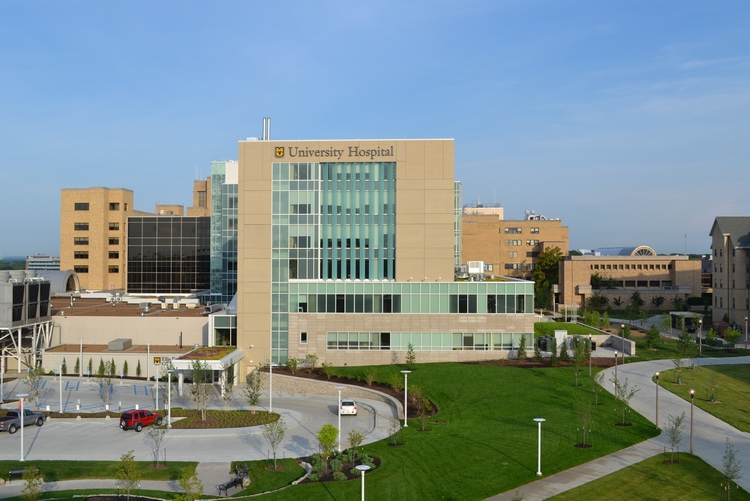COLUMBIA, Mo. — University of Missouri Health Care’s largest expansion has earned LEED Gold certification through a creative approach tying sustainability into improving patient-centered care on the campus of University Hospital in Columbia, Mo. Designed by HOK, the $190-million addition created a new a patient care tower and a replacement facility for the Ellis Fischel Cancer Center – the oldest cancer center west of the Mississippi River. JE Dunn Construction Co., Kansas City, Mo., was construction manager for the project.
One of the primary achievements was optimizing beneficial patient views of the surrounding landscape. The building’s north-south orientation provides panoramic views of Missouri farmland to the south and the University of Missouri campus to the north, while sunshades on the south façade help mitigate the glare from direct sunlight. Roof gardens covering more than 10,000 square feet can also be viewed on the north and south sides of the building, providing patients with an immediate view to nature while mechanical systems and other necessary infrastructure become less noticeable.
The connection to nature is amplified by the centrally located Ellis Fischel Gala and Brown Family Healing Garden Courtyard that is the hospital’s primary wayfinding element. Designed to reduce stress in patients and staff, the 3,150-square-foot healing garden optimizes sunlight and is a focal point of healing while being accessible to all physical abilities. Visible from all floors of the surrounding buildings, it serves as a crossroads between the new addition and the main hospital.
MU Health Care originally sought LEED certification for the 310,500-square-foot addition, but HOK was able to exceed that goal and achieve a LEED Gold rating by:
- Tying environmental systems into the University of Missouri’s existing biomass boiler. Completed in 2012, it replaced a coal-burning boiler with one that burns hardwoods and wood waste to reduce the fossil fuel use of the campus by 25 percent.
- Using locally sourced material such as limestone quarried in Ste. Genevieve, Mo., or recycled content from two nearby demolished dorms.
- Using a high-performance building skin based on a panelized system of limestone, brick and glazed panels fabricated in a controlled factory environment. Thermal transfer through the wall was minimized by using an open joint rainscreen system on the stone façade, allowing a continuous air and water barrier across the façade. In addition, the open joint system will greatly reduce future maintenance and repairs on the façade.
- Providing more efficient fixtures to reduce potable water use by 46 percent.
- Using low VOC-emitting finish materials.
- Optimizing natural light with high-efficiency glass.
The eight-story tower was an addition to the northeast side of the existing hospital. It is designed to support the delivery of patient- and family centered care; advance translational research and education; provide flexibility for growth of the university’s health science campus and foster greater collaboration. The tower includes:
- 90 private rooms with “smart room” technology that wirelessly integrates medical devices into the hospital’s electronic medical record keeping.
- A 7,000-square-foot inpatient pharmacy with robotics to automatically dispense medications.
- Six operating rooms, with space to add up to six more operating rooms.
- 25 pre-procedure rooms and 18 post-procedure recovery rooms.
- A nearly 1,800-square-foot lounge for families of surgery patients.
The tower is also home to the new Ellis Fischel Cancer Center, which moved from a separate outpatient facility. Integrating the cancer center into the patient tower allows inpatient and outpatient care from a single location and a more efficient use of valuable resources. The 100,000-square-foot cancer center spans two floors and includes two linear accelerators, space for two magnetic resonance imaging rooms, a PET-CT scanner, a CT scanner and 66 clinical examination rooms.





